2000 FORD EXPEDITION load capacity
[x] Cancel search: load capacityPage 150 of 256
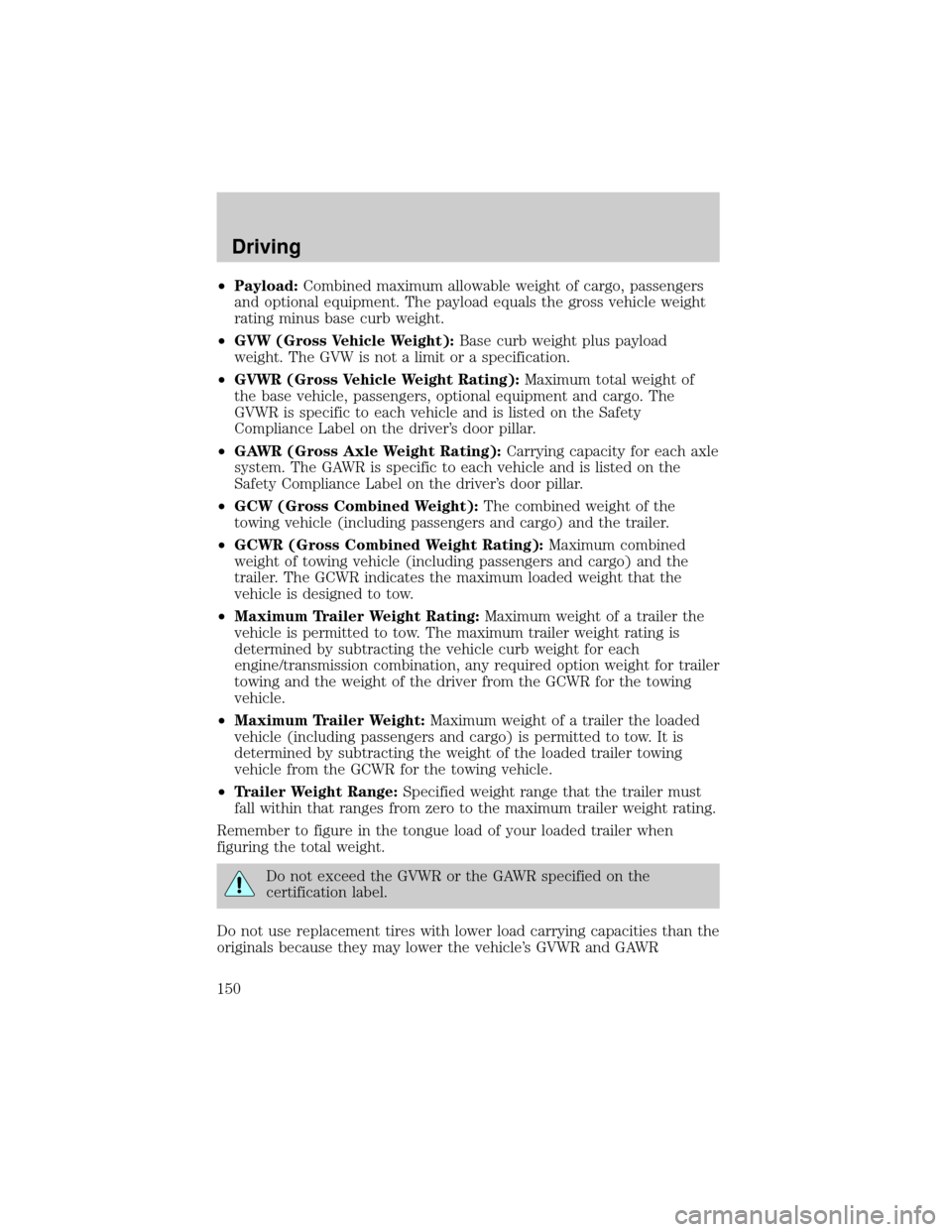
²Payload:Combined maximum allowable weight of cargo, passengers
and optional equipment. The payload equals the gross vehicle weight
rating minus base curb weight.
²GVW (Gross Vehicle Weight):Base curb weight plus payload
weight. The GVW is not a limit or a specification.
²GVWR (Gross Vehicle Weight Rating):Maximum total weight of
the base vehicle, passengers, optional equipment and cargo. The
GVWR is specific to each vehicle and is listed on the Safety
Compliance Label on the driver's door pillar.
²GAWR (Gross Axle Weight Rating):Carrying capacity for each axle
system. The GAWR is specific to each vehicle and is listed on the
Safety Compliance Label on the driver's door pillar.
²GCW (Gross Combined Weight):The combined weight of the
towing vehicle (including passengers and cargo) and the trailer.
²GCWR (Gross Combined Weight Rating):Maximum combined
weight of towing vehicle (including passengers and cargo) and the
trailer. The GCWR indicates the maximum loaded weight that the
vehicle is designed to tow.
²Maximum Trailer Weight Rating:Maximum weight of a trailer the
vehicle is permitted to tow. The maximum trailer weight rating is
determined by subtracting the vehicle curb weight for each
engine/transmission combination, any required option weight for trailer
towing and the weight of the driver from the GCWR for the towing
vehicle.
²Maximum Trailer Weight:Maximum weight of a trailer the loaded
vehicle (including passengers and cargo) is permitted to tow. It is
determined by subtracting the weight of the loaded trailer towing
vehicle from the GCWR for the towing vehicle.
²Trailer Weight Range:Specified weight range that the trailer must
fall within that ranges from zero to the maximum trailer weight rating.
Remember to figure in the tongue load of your loaded trailer when
figuring the total weight.
Do not exceed the GVWR or the GAWR specified on the
certification label.
Do not use replacement tires with lower load carrying capacities than the
originals because they may lower the vehicle's GVWR and GAWR
Driving
150
Page 151 of 256
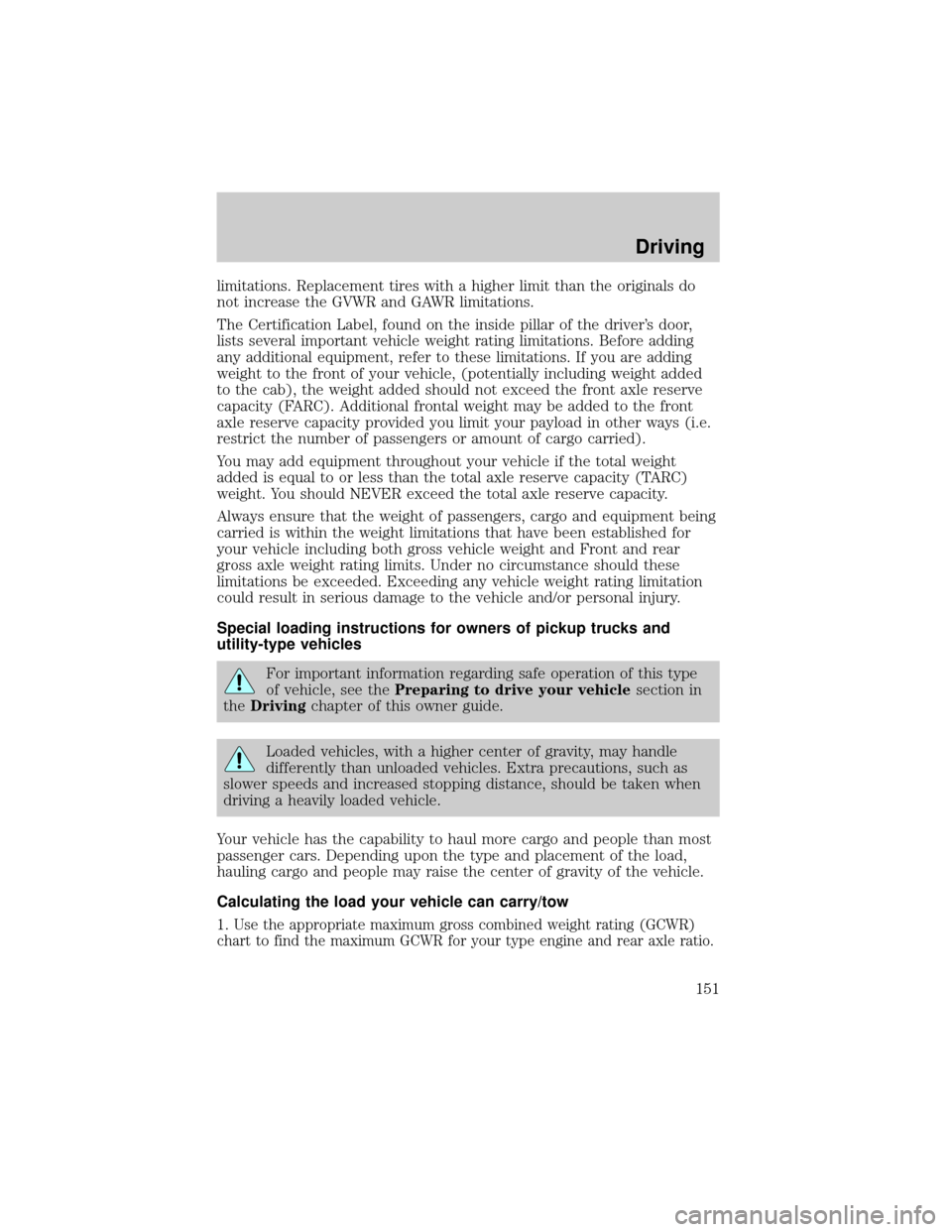
limitations. Replacement tires with a higher limit than the originals do
not increase the GVWR and GAWR limitations.
The Certification Label, found on the inside pillar of the driver's door,
lists several important vehicle weight rating limitations. Before adding
any additional equipment, refer to these limitations. If you are adding
weight to the front of your vehicle, (potentially including weight added
to the cab), the weight added should not exceed the front axle reserve
capacity (FARC). Additional frontal weight may be added to the front
axle reserve capacity provided you limit your payload in other ways (i.e.
restrict the number of passengers or amount of cargo carried).
You may add equipment throughout your vehicle if the total weight
added is equal to or less than the total axle reserve capacity (TARC)
weight. You should NEVER exceed the total axle reserve capacity.
Always ensure that the weight of passengers, cargo and equipment being
carried is within the weight limitations that have been established for
your vehicle including both gross vehicle weight and Front and rear
gross axle weight rating limits. Under no circumstance should these
limitations be exceeded. Exceeding any vehicle weight rating limitation
could result in serious damage to the vehicle and/or personal injury.
Special loading instructions for owners of pickup trucks and
utility-type vehicles
For important information regarding safe operation of this type
of vehicle, see thePreparing to drive your vehiclesection in
theDrivingchapter of this owner guide.
Loaded vehicles, with a higher center of gravity, may handle
differently than unloaded vehicles. Extra precautions, such as
slower speeds and increased stopping distance, should be taken when
driving a heavily loaded vehicle.
Your vehicle has the capability to haul more cargo and people than most
passenger cars. Depending upon the type and placement of the load,
hauling cargo and people may raise the center of gravity of the vehicle.
Calculating the load your vehicle can carry/tow
1.
Use the appropriate maximum gross combined weight rating (GCWR)
chart to find the maximum GCWR for your type engine and rear axle ratio.
Driving
151
Page 204 of 256
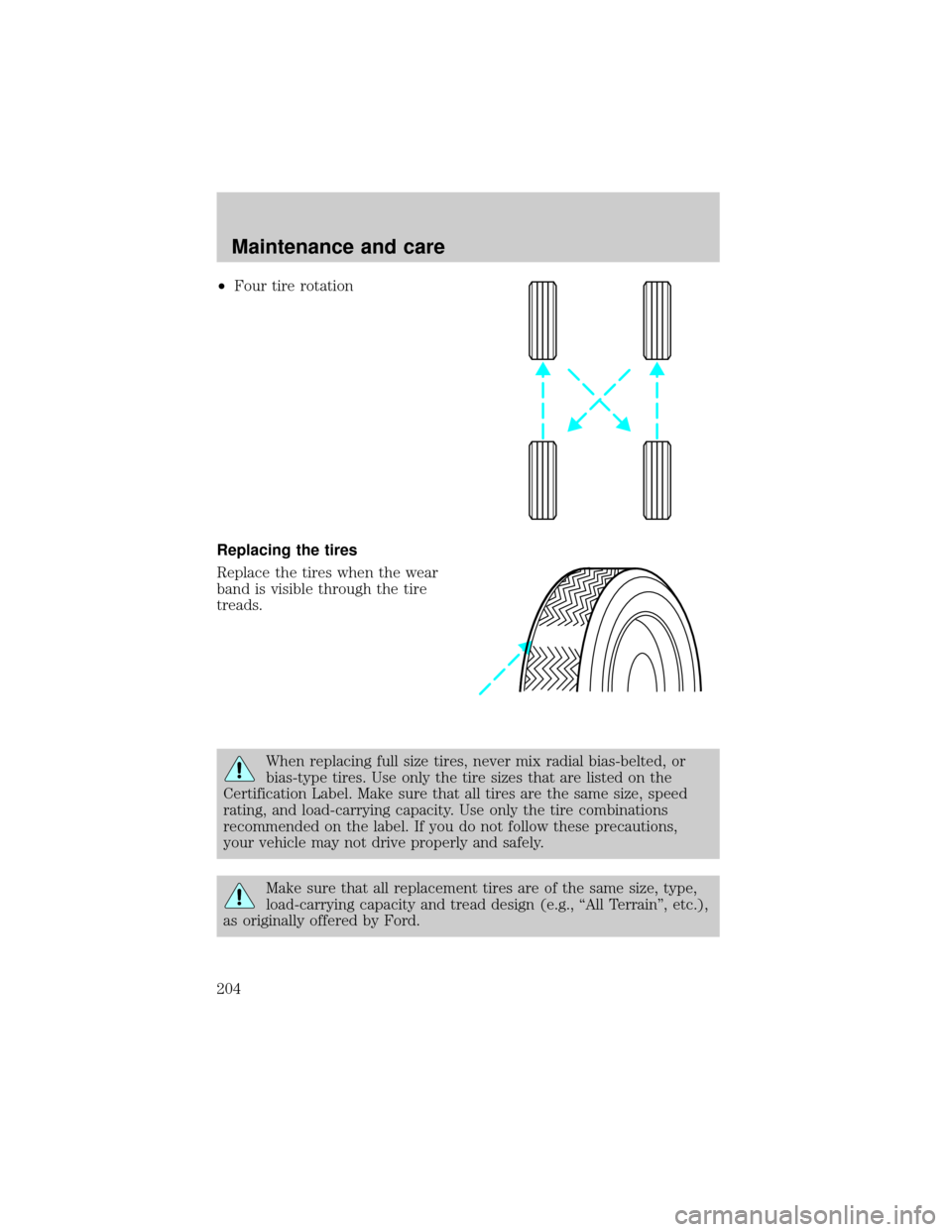
²Four tire rotation
Replacing the tires
Replace the tires when the wear
band is visible through the tire
treads.
When replacing full size tires, never mix radial bias-belted, or
bias-type tires. Use only the tire sizes that are listed on the
Certification Label. Make sure that all tires are the same size, speed
rating, and load-carrying capacity. Use only the tire combinations
recommended on the label. If you do not follow these precautions,
your vehicle may not drive properly and safely.
Make sure that all replacement tires are of the same size, type,
load-carrying capacity and tread design (e.g., ªAll Terrainº, etc.),
as originally offered by Ford.
Maintenance and care
204
Page 211 of 256

The amount of empty reserve varies and should not be relied
upon to increase driving range. When refueling your vehicle after
the fuel gauge indicates empty, you might not be able to refuel
the full amount of the advertised capacity of the fuel tank due to
the empty reserve still present in the tank.
For consistent results when filling the fuel tank:
²Use the same filling rate setting (low Ð medium Ð high) each time
the tank is filled.
²Allow three automatic click-offs when filling.
²Always use fuel with the recommended octane rating.
²Use a known quality gasoline, preferably a national brand.
²Use the same side of the same pump and have the vehicle facing the
same direction each time you fill up.
²Have the vehicle loading and distribution the same every time.
Your results will be most accurate if your filling method is consistent.
Calculating fuel economy
1. Fill the fuel tank completely and record the initial odometer reading
(in kilometers or miles).
2. Each time you fill the tank, record the amount of fuel added (in liters
or gallons).
3. After at least three to five tank fill-ups, fill the fuel tank and record
the current odometer reading.
4. Subtract your initial odometer reading from the current odometer
reading.
5. Follow one of the simple calculations in order to determine fuel
economy:
Multiply liters used by 100, then divide by total kilometers
traveled.
Divide total miles traveled by total gallons used.
Keep a record for at least one month and record the type of driving (city
or highway). This will provide an accurate estimate of the vehicle's fuel
economy under current driving conditions. Additionally, keeping records
during summer and winter will show how temperature impacts fuel
economy. In general, lower temperatures give lower fuel economy.
Maintenance and care
211
Page 226 of 256
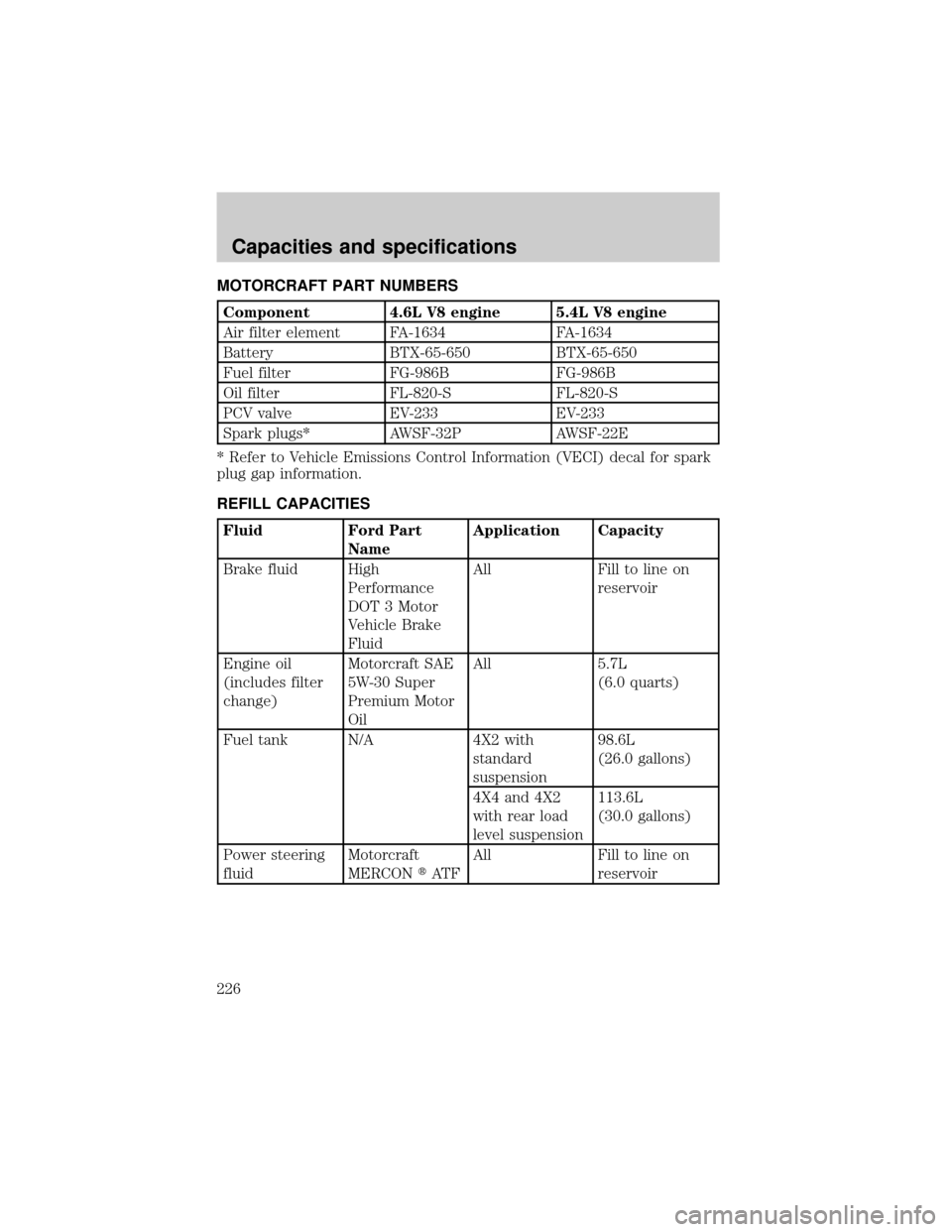
MOTORCRAFT PART NUMBERS
Component 4.6L V8 engine 5.4L V8 engine
Air filter element FA-1634 FA-1634
Battery BTX-65-650 BTX-65-650
Fuel filter FG-986B FG-986B
Oil filter FL-820-S FL-820-S
PCV valve EV-233 EV-233
Spark plugs* AWSF-32P AWSF-22E
* Refer to Vehicle Emissions Control Information (VECI) decal for spark
plug gap information.
REFILL CAPACITIES
Fluid Ford Part
NameApplication Capacity
Brake fluid High
Performance
DOT 3 Motor
Vehicle Brake
FluidAll Fill to line on
reservoir
Engine oil
(includes filter
change)Motorcraft SAE
5W-30 Super
Premium Motor
OilAll 5.7L
(6.0 quarts)
Fuel tank N/A 4X2 with
standard
suspension98.6L
(26.0 gallons)
4X4 and 4X2
with rear load
level suspension113.6L
(30.0 gallons)
Power steering
fluidMotorcraft
MERCONtAT FAll Fill to line on
reservoir
Capacities and specifications
226
Page 250 of 256

Floor mats ...................................81
Fluid capacities .........................226
Foglamps .....................................20
Four-Wheel Drive vehicles ..12,144
control trac ........................22,145
description ..............................145
driving off road .......................147
electronic shift ...................22,146
indicator light ...........................12
preparing to
drive your vehicle ...................140
Fuel ............................................206
calculating fuel economy .......210
cap ...........................................209
capacity ...................................226
choosing the right fuel ...........208
comparisons with EPA fuel
economy estimates .................213
detergent in fuel .....................209
filling your vehicle
with fuel ....................206,209,210
filter, specifications .........210,226
fuel pump shut-off switch .....160
gauge .........................................14
improving fuel economy ........210
low fuel warning light ................8
octane rating ....................208,232
quality ......................................208
running out of fuel .................209
safety information relating
to automotive fuels ................206
Fuses ...................................161,162
Garage door opener ....................70
Gas cap (see Fuel cap) ............209
Gas mileage
(see Fuel economy) .................210
Gauges .........................................14
battery voltage gauge ...............16
engine coolant
temperature gauge ...................15
engine oil pressure gauge ........16
fuel gauge ..................................14odometer ...................................15
speedometer .............................14
tachometer ................................16
trip odometer ............................15
GAWR
(Gross Axle Weight Rating) .....149
calculating ...............................151
definition .................................149
driving with a heavy load ......149
location ....................................149
GVWR (Gross
Vehicle Weight Rating) .............149
calculating ........................149,151
definition .................................149
driving with a heavy load ......149
location ....................................149
Hazard flashers .........................160
Head restraints ......................92,97
Headlamps ...................................19
aiming ......................................221
autolamp system .......................20
bulb specifications ..................219
daytime running lights .............19
flash to pass ..............................19
high beam ............................11,19
replacing bulbs .......................216
turning on and off ....................19
warning chime ..........................13
Heating ........................................51
heating and
air conditioning system ............51
Hood ..........................................182
Ignition .......................................232
positions of the ignition ...........62
Infant seats
(see Safety seats) .....................123
Inspection/maintenance
(I/M) testing ..............................215
Instrument panel
cleaning ...................................224
cluster ...................................8,224
Index
250
Page 251 of 256

lighting up
panel and interior .....................20
location of components ..............8
Jump-starting your vehicle ......175
Keyless entry system
autolock .....................................89
locking and unlocking doors ....91
programming entry code .........90
Keys
key in ignition chime ...............13
positions of the ignition ...........62
Lamps
autolamp system .......................20
bulb replacement
specifications chart ................219
cargo lamps ...............................20
daytime running light ...............19
fog lamps ...................................20
headlamps .................................19
headlamps, flash to pass ..........19
instrument panel, dimming .....20
interior lamps ...............75,76,220
replacing
bulbs ............215,216,217,218,219
Lane change indicator
(see Turn signal) ........................63
Liftgate ........................................81
Lights, warning and indicator ......8
air bag ..........................................9
air suspension .........................139
anti-lock brakes (ABS) .....10,135
anti-theft ...................................11
brake ..........................................10
charging system ........................11
check coolant ............................11
cruise indicator .........................12
door ajar ....................................12
engine oil pressure ...................11
high beam .................................11
low fuel ........................................8
low washer fluid .......................12
safety belt .................................10service engine soon ....................8
turn signal indicator .................10
Load limits .................................149
GAWR ......................................149
GVWR ......................................149
trailer towing ..........................149
Loading instructions .................151
Locks
autolock .....................................89
childproof ..................................78
doors ..........................................78
Lubricant specifications ....229,232
Lumbar support, seats ...............92
Message center ......................17,71
english/metric button ...............17
menu button .............................17
Mirrors .........................................76
automatic dimming
rearview mirror .........................76
fold away ...................................80
heated ........................................79
programmable memory ............88
side view mirrors (power) .......79
Moon roof ....................................70
Motorcraft parts .................210,226
Octane rating ............................208
Odometer .....................................15
Oil (see Engine oil) ..................183
Overdrive .....................................68
Panic alarm feature, remote
entry system ................................85
Parking brake ............................136
Parts (see Motorcraft parts) ....226
Pedals (see Power
adjustable foot pedals) ...............21
Power adjustable foot pedals .....21
Power distribution box
(see Fuses) ...............................166
Power door locks ...................78,89
Power steering ...................137,138
fluid, checking and adding ....193
fluid, refill capacity ................226
Index
251
Page 255 of 256
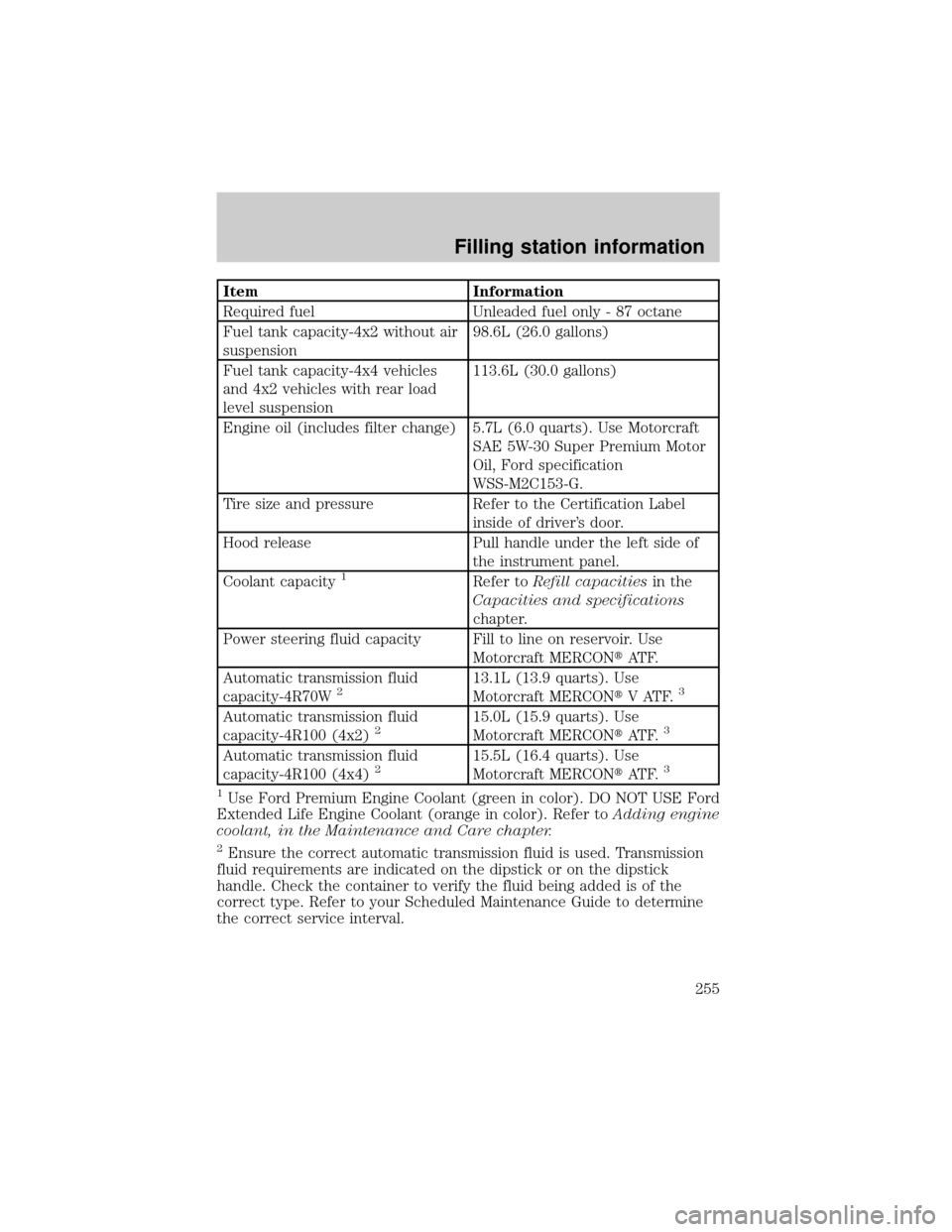
Item Information
Required fuel Unleaded fuel only - 87 octane
Fuel tank capacity-4x2 without air
suspension98.6L (26.0 gallons)
Fuel tank capacity-4x4 vehicles
and 4x2 vehicles with rear load
level suspension113.6L (30.0 gallons)
Engine oil (includes filter change) 5.7L (6.0 quarts). Use Motorcraft
SAE 5W-30 Super Premium Motor
Oil, Ford specification
WSS-M2C153-G.
Tire size and pressure Refer to the Certification Label
inside of driver's door.
Hood release Pull handle under the left side of
the instrument panel.
Coolant capacity
1Refer toRefill capacitiesin the
Capacities and specifications
chapter.
Power steering fluid capacity Fill to line on reservoir. Use
Motorcraft MERCONtAT F.
Automatic transmission fluid
capacity-4R70W
213.1L (13.9 quarts). Use
Motorcraft MERCONtV ATF.3
Automatic transmission fluid
capacity-4R100 (4x2)215.0L (15.9 quarts). Use
Motorcraft MERCONtAT F.3
Automatic transmission fluid
capacity-4R100 (4x4)215.5L (16.4 quarts). Use
Motorcraft MERCONtAT F.3
1
Use Ford Premium Engine Coolant (green in color). DO NOT USE Ford
Extended Life Engine Coolant (orange in color). Refer toAdding engine
coolant, in the Maintenance and Care chapter.
2Ensure the correct automatic transmission fluid is used. Transmission
fluid requirements are indicated on the dipstick or on the dipstick
handle. Check the container to verify the fluid being added is of the
correct type. Refer to your Scheduled Maintenance Guide to determine
the correct service interval.
Filling station information
255